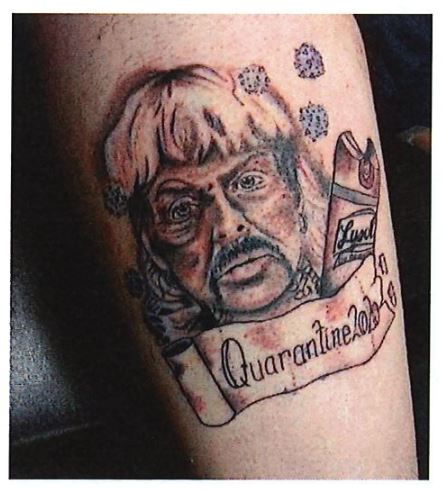This Blog Has Jumped the Shark: I’m Covering a Copyright Opinion About a Tattoo of Tiger King’s Joe Exotic–Cramer v. Netflix
In the early days of the pandemic, tattoo artist Cramer created this tattoo and tattooed it onto her husband:
The tattoo depicts Joe Exotic of Tiger King “fame,” a can of Lysol, some coronaviruses, and the words “Quarantine 2020.” None of this makes any sense to me. I guess you had to be there. Cramer apparently had no affiliation with either Joe Exotic or Lysol.
Netflix broadcast a popular documentary series called “Tiger King.” The first episode of the second season contains a rapid-fire montage establishing how the first season turned Joe Exotic into a pop culture sensation, including this image that displayed for 2.2 seconds:
 As you can see, the tattoo photograph appears in the bottom left corner. For 2.2 seconds. For this, Cramer demanded $10M dollars from Netflix (later dropped to $50k).
As you can see, the tattoo photograph appears in the bottom left corner. For 2.2 seconds. For this, Cramer demanded $10M dollars from Netflix (later dropped to $50k).
Cramer does not get the $10M. Or the $50k. Instead, she gets a 12(b)(6) dismissal based on fair use. And maybe a 505 fee shift. In other words, not even close.
Purpose and Character of Use.
Plaintiff admittedly designed her Tattoo with the intent of capitalizing on the mass following first created by Netflix’s first season of the Tiger King series and the public’s resulting fascination with Joe Exotic….Plaintiff’s tattoo design is undisputedly a byproduct of the cultural phenom created by Season One of Netflix’s Tiger King series. The Tattoo was created to capitalize on the portrayal of Joe Exotic created by Defendants’ series, and that is why there is a seeming similarity in purpose, not vice versa.
Also…
The purpose and character of the Defendants’ use of the Tattoo is as part of a visual and auditory compilation depicting the public’s overwhelming fascination with and reaction to Joe Exotic in the early days of the pandemic, and thus falls into the “criticism,” “comment,” or “reporting” that is expressly defined as “fair use”
The Goldsmith ruling doesn’t change the analysis because the tattoo and the montage served “fundamentally different” purposes and Netflix doesn’t compete with a tattoo artist for tattoo services.
Nature of Work. Favors plaintiff, but only a little because of the transformative use.
Amount and Substantiality of Portion Used. “use of the entire image of the Tattoo in the 8-way split screen montage, with visual and audio effects, is appropriate to Defendants’ transformative purpose of showing the public’s reaction to Season One of the Tiger King series.”
Market Effect. The litigants are in different markets. “Plaintiff sells tattoos and gift cards for her tattoo business, and Defendants sell a streaming media service.” The court doesn’t address the potential licensing market for the tattoo design.
Implications
This case generally sidesteps the interesting issues involving tattoos and copyrights, but the ruling does have tattoo-specific elements. Netflix included the image in the montage because a tattoo of Joe Exotic is (at least to this GenXer) a pretty extreme response to a TV broadcast. Had the same drawing not been tattooed, Netflix almost certainly not included the drawing in the montage because it would not have been as sensational. Plus, the tattoo affected the fair use analysis because it established the impossibility of competitive tension between the tattoo artist and Netflix.
(The court never addresses who owned the photograph’s copyright, but they might have had a better claim than the tattoo artist).
The court also largely sidesteps the documentary’s brief display of the image. Less than 3 seconds and only a small fraction of screen real estate makes this depiction a good candidate for “de minimis infringement,” but the doctrine isn’t universally accepted. It’s a sad fact of documentary filmmaking that virtually every visual element on every screen create copyright infringement exposure, even if it’s just depictions of the real world and only shown on-screen briefly. Rulings like this help documentary filmmakers feel a little more comfortable, but their producers still tend to be cautious given the number and pugnaciousness of potential plaintiffs.
Finally, the Goldsmith case has generally been regarded as an adverse development for defendants. It’s nice to see the court use the Goldsmith case to cement the defense’s fair use win.
A fair use win on a motion to dismiss is a good candidate for a 505 fee shift.
Case Citation: Cramer v. Netflix, Inc., 2023 WL 6130030 (W.D. Pa. Sept. 18, 2023)
Prior Tattoo Copyright Blog Posts
- Jury Awards Damages to Tattoo Artist for Video-Game Depiction–Alexander v. WWE 2K
- Can Tattoos Infringe Copyrights, and If So, What Happens Then?–Sedlik v. Kat Von D
- Depicting Randy Orton’s Tattoos in a Video Game Could Be Copyright Infringement–Alexander v. WWE 2K
- Videogame Doesn’t Infringe Tattoo Copyright By Depicting Basketball Players–Solid Oak Sketches v. 2K Games
- Copyright and Tattoos: Hangover II Injunction Denied, But the Copyright Owner Got Some Good News Too–Whitmill v. Warner Bros.
- Tattoo Advertising/Human Billboards
- Copyright in Tattoos
- Also, see Q2 of my 2005 contracts law exam and the sample answer.


